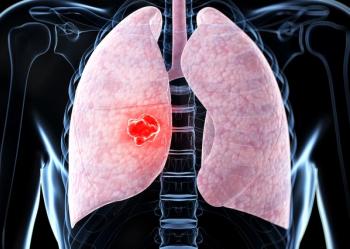
Oncology NEWS International
- Oncology NEWS International Vol 10 No 10
- Volume 10
- Issue 10
Shorter Follow-up for Aspiration-Negative Breast Masses
SEATTLE-A 1-year follow-up with mammography appears to be sufficient to detect any false-negative results of ultrasound-guided fine-needle aspiration in patients with nonpalpable breast masses, according to a study from the Montefiore Medical Center, Bronx, NY. Shalom Buchbinder, MD, director of mammography, presented the study at the 101st Annual Meeting of the American Roentgen Ray Society.
SEATTLEA 1-year follow-up with mammography appears to be sufficient to detect any false-negative results of ultrasound-guided fine-needle aspiration in patients with nonpalpable breast masses, according to a study from the Montefiore Medical Center, Bronx, NY. Shalom Buchbinder, MD, director of mammography, presented the study at the 101st Annual Meeting of the American Roentgen Ray Society.
The retrospective study evaluated the necessity for the currently recommended but controversial 2-year follow-up. These 2 years are often a time of anxious uncertainty for patients and physicians alike, Dr. Buchbinder said. A shorter follow-up would be preferableprovided that it caught any false-negative results of fine-needle aspiration.
"Essentially, we wanted to see how long it would take for our false-negative aspirations to manifest themselves with malignancy," he explained.
The researchers reviewed all of the cases of nonpalpable masses detected by mammograms or sonograms and sampled by ultrasound-guided fine-needle aspiration between January 1995 and March 1998. The sampling was performed with a 25- or 27-gauge needle under ultrasound guidance, and the samples were immediately handed to a cytopathologist, who prepared the slides and made an initial and final interpretation (benign, malignant, or atypical).
"This triad of mass lesions only, ultrasound guidance, and on-site, specialized cytopathologists is really necessary in order to maximize the correct diagnosis of these fine-needle aspirations," Dr. Buchbinder emphasized in his talk.
The investigators did not use fine-needle aspiration to sample microcalcifications because these lesions often represent heterogeneous populations of cells, and aspiration harvests only a small sample. In contrast, samples from masses allow greater diagnostic certainty. "We assume that a mass has a relatively homogeneous population of cells and that any harvesting from that mass will be representative of that mass," he said.
Specialized cytopathologists are also essential for the success of an ultrasound-guided fine-needle aspiration program. "We are fortunate at Albert Einstein-Montefiore that we have a group that initially trained at the Karolinska Institute in Sweden, which is one of the preeminent cytopathology centers in the world," he said.
The results of fine-needle aspiration cytopathology were benign in 85 cases, malignant in 11 cases, and atypical (not to be confused with atypical ductal hyperplasia) in 21 cases, Dr. Buchbinder said. The patients with malignant results underwent excisional biopsy, and the patients with atypical results were advised to undergo excisional biopsy to verify the diagnosis. All of the patients were advised to have mammograms at 6-month intervals.
The compliance with mammography at 6-month intervals was less than ideal. About 25% of the patients underwent mammography at 6 months, 51% at 12 months, 21% at 18 months, and 97% at approximately 24 months, Dr. Buchbinder said. The lesions were excised in three cases because the patients did not want to deal with the uncertainty, he said.
During the entire 24-month mammographic follow-up in the 85 patients with negative aspiration results, only one true false-negative aspiration result was detected, Dr. Buchbinder said. "This small number somewhat limits the ability to establish length of time before a malignant manifestation appears but, at the same time, strongly supports the correctness of the initial diagnosis," he said.
The missed cancer was detected on a mammogram performed at 12 months of follow-up in a patient who had not had a mammogram at 6 months. This case occurred early in the implementation of the ultrasound-guided fine-needle aspiration program at Montefiore, Dr. Buchbinder noted, and they have since had no known false-negative aspiration results.
The sensitivity, specificity, positive predictive value, and negative predictive value of fine-needle aspiration plus mammography were all 100% at 12 months. The second year of follow-up after a negative result on aspiration did not add any benefit, Dr. Buchbinder concluded.
"By 12 months, everybody who indeed had cancer was identified. Conversely, all benign diagnosis, confirmed by the initial aspiration and incorporating the follow-up 12-month mammography, proved to be benign at 12 months as well," he said.
Articles in this issue
about 24 years ago
High-Dose IL-2 Is Standard in Advanced Renal Cell Cancerabout 24 years ago
RIT Safe, Effective in Elderly and Poor-Prognosis Patientsabout 24 years ago
FDA Approves Xeloda/Taxotere Combination for Advanced Breast Cancerabout 24 years ago
ODAC Recommends Approval of Radiolabeled Zevalinabout 24 years ago
Proteomics Moves From the Laboratory to Clinical Researchabout 24 years ago
Radiotherapy Not Needed in Older Lumpectomy Patients With Early Cancerabout 24 years ago
Raltitrexed + Oxaliplatin for Advanced Colorectal Cancerabout 24 years ago
Mental Fatigue Worries Chemotherapy Patientsabout 24 years ago
Patients Urged to Work With Professionals Against Fatigueabout 24 years ago
NCI Director Resigns to Head New Scientific InstituteNewsletter
Stay up to date on recent advances in the multidisciplinary approach to cancer.

















































































